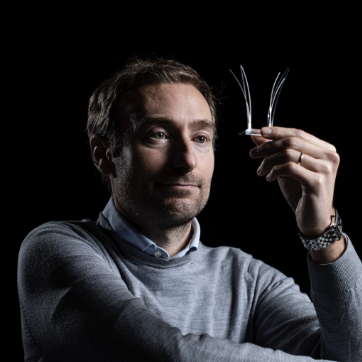Tackling antibiotic use in the clinic
2 December 2020
5 mins to read
Antibiotics: The magical cure
Since antibiotics became commonly prescribed from the 1950s, they have been enthusiastically embraced and taken for granted as a type of medical magic in infection treatment. Yet as soon as we started to use them, bacteria began to develop resistance, in a cat-and-mouse evolutionary arms race which has seen, increasingly, the pathogens winning.
Fast forward to 2020, and society has developed an addiction to antibiotics. Yet examples of resistance have been recorded against virtually every class of antibiotic and antifungal drug ever developed, meaning that their use is often compromised or ineffective. Like COVID-19, resistant microbes can spread from human-to-human, transcending social barriers and international borders. If we don’t take action, the age of antibiotics could become a fleeting century in human medical history.
Yet the issue is complex and global. In some countries, antibiotic prescribing is still unregulated, and even the most important antibiotics that would normally require a doctor to prescribe can be bought over the counter. In others, a lack of access to antibiotics already accounts for 5.7 million deaths per year – there’s a desperate need for these drugs because they save lives. Tackling the wide-ranging and growing concerns over antimicrobial resistance (AMR) requires multidisciplinary approaches and research. Exeter’s One Health approach brings together experts across the disciplines to combine knowledge in a holistic response to AMR.
In the clinic, people often believe antibiotics are the fastest route to a cure, and time-poor clinicians are under pressure to prescribe something to treat infections that may already be resolving or do not require the use of an antibiotic. When they do, it can be difficult to establish what antibiotic is best to treat a specific infection. They may be tempted to over-prescribe antimicrobials, meaning more antibiotics are circulating in the environment, in turn driving more resistance.
To address this, we need widespread change, from global medical policies to changing public expectations and bespoke clinical training. Health professionals desperately need better ways of diagnosing infections so they can prescribe efficiently and effectively in a targeted and precise way. Simultaneously, we need ways to improve treatments, so they work first time and come up with new drugs that work against drug resistant species and ways of combatting infections that don’t rely solely on the use of antibiotics.


Studying antibiotic resistance cell by cell
Among those leading the charge is Dr Stefano Pagliara, Senior Lecturer in Biomicrofluidics at the University of Exeter. His work aims to create ways to swiftly establish which antibiotics can work against a specific infection, and how to ensure the treatment permeates the cell quickly and effectively.
His team at Exeter’s multidisciplinary Living Systems Institute is investigating how individual cells react in the presence of particular antibiotics, using microfluidics. "Pathogens are very clever," the physicist explained. "They change their behaviour to escape the damaging effects of antibiotics. Traditionally, scientists have examined cells at the population level, but to understand what really influences whether an antibiotic can penetrate the cell, or whether it has evolved resistance, we need to be able to capture these minute differences in individual specialised cells, as well as study the response of an entire cell population."
"They change their behaviour to escape the damaging effects of antibiotics. Traditionally, scientists have examined cells at the population level, but to understand what really influences whether an antibiotic can penetrate the cell, or whether it has evolved resistance, we need to be able to capture these minute differences in individual specialised cells, as well as study the response of an entire cell population."
Dr Stefano Pagliara
Lecturer in Biomircofluidics at the University of Exeter

The obstacle course of cell penetration
One key aspect of investigation is how antibiotics penetrate the membrane of a cell, which affects whether they can work effectively. Cells differ in their structure. Gram-negative bacteria are surrounded by a very complex multi-layered cell membrane. This creates a complex labyrinth for a molecule of antibiotic to cross, introducing various barriers that it must overcome. To further hinder the efforts of the antibiotic, gram-negative bacteria also have mechanisms that effectively pump toxic compounds, such as antibiotics, back out of the cell. This means that far fewer antibiotics exist for gram-negative bacteria such as Pseudomonas aeruginosa, and Acinetobacter baumannii, than for gram-positive bacteria such as Streptococcus pneumonia and Staphylococcus aureus, which have a much simpler single layer membrane for the drug to penetrate.
To add even more obstacles to the antibiotic’s cell-penetration mission, the team discovered that cells in different metabolic states accumulate antibiotics to different extents – thus within a population of genetically identical cells, individuals in different metabolic states may react to antibiotic treatments very differently. The team also found that bacterial populations contain ‘sleeper cells’ that survive antibiotic treatment by remaining dormant. These ‘sleeper cells’ mimic those that have been killed by antibiotics, yet can wake up, and re-infect their host. Tracking individual bacteria that can escape antibiotics through these diverse routes could ultimately help target and eradicate such cells more effectively.
The map of drug uptake routes is becoming ever-more detailed. Dr Jehangir Cama, Industry Research Fellow at the University of Exeter’s Living Systems Institute, said the centre’s collaborative approach had fostered work with mathematicians, who are now applying mathematical modelling to the data to establish exactly where in the cell the drugs were reaching, with the aim of understanding if the drug molecules had hit their desired targets. “It’s a fantastic culture for encouraging cross-disciplinary collaboration,” he said. “We bump into each other over coffee, and ideas begin to coalesce. It’s great to be part of this ecosystem!”
"It’s a fantastic culture for encouraging cross-disciplinary collaboration, we bump into each other over coffee, and ideas begin to coalesce. It’s great to be part of this ecosystem!"
Dr Jehangir Cama
Industrial Research Fellow
A glowing result
To date, the team has used the antibiotic ofloxacin, which is fluorescent under ultraviolet light. Bacteria also glow when the antibiotic is taken up, so if the antibiotic penetrates the cell, it glows under the microscope. If they remain dark, the antibiotic has not entered the cell and will not kill the bacteria. The team is now working on expanding the technique, by manipulating the fluorescent qualities of other forms of antibiotics so they can be studied in the same way.
While the research is still at an early stage, and has a number of challenges to overcome, it offers new experimental-theoretical modalities for quantitatively studying this crucial drug accumulation process in individual cells. Using the technique to understand the chemical properties of drug molecules that promote intracellular accumulation will provide crucial information for pharmaceutical companies, helping in the rational design of next-generation antibiotics that are desperately needed. The technology could also be used to test the accumulation of currently available antibiotics in cells directly sampled from infections in patients.

In the meantime, the team is developing a large interdisciplinary network of more than 100 academics, with private companies and clinicians, to combine expertise in a One Health approach to introduce microfluidic technology into clinics.
Dr Pagliara said: “An important goal is to develop devices that could sit in clinical settings, enabling health professionals in every GP and hospital to quickly test patient samples with several antibiotics. It could establish whether antibiotics will work and if so which to prescribe, with far more certainty that the chosen drug will be effective.”
Meet our researchers








